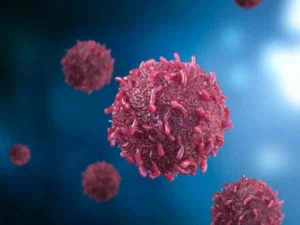Know about Typhoid

The test that is done to check for typhoid i.e. temporary fever is called the Widal test.
Typhoid test is done in two ways
- one by Vidal
- typhoid kit
Vidal test
The Vidal test is a serological test and was discovered in 1896 by Grimbaum and Vidal. This test helps in detecting the Gram-negative bacteria Salmonella Typhi.
Salmonella typhi is the main cause of typhoid.
Salmonella typhi has an O antigen on its cell wall and an H antigen is found in its flagella. When there is an infection due to Salmonella typhi in the body, a special antibody is produced due to these antigens inside our body.
These antibodies are detected by the Widal test. These antibodies can be recognized only a week after infection.
How is the Vidal test done?
The Widal test is an agglutination test in which one’s antigen is mixed with one’s antibody.
In this, the patient’s serum is mixed with a suspension of dead bacteria O&H.
If the serum contains antibodies to bacteria, they will react with the antigen to form clumps, which will appear on the slide.
We can understand the intensity of typhoid fever by the Vidal test. Many reports have a + sign, and many have a value of 1:180 or 1:240 or similar.
The higher the infection, the higher this value will be or the signs of +, ++, +++, etc. will be formed. If positive, it indicates typhoid infection.
What is a typhoid test?
A typhoid test is a very easy way to measure typhoid infection.
In this, the patient’s serum is put in a kit and she immediately tells whether the patient has typhoid infection or not.
Its report is not as complicated as that of the Widal test and one can understand it by looking at it in one go. The typhoid test is also easy for doctors.
How much do the Widal test and typhoid test cost?
The Widal test is cheap and costs around Rs 200. Whereas a typhoid test is done for around Rs 400. (Can be varies)
Most of the labs these days prefer the typhoid test because it is very easy to do.
Let us now know something about the disease for which the Vidal test is done.
What is typhoid
Typhoid is an infection caused by bacteria called Salmonella typhi. The main cause of typhoid is infected food and water. When you have typhoid, you start getting a fever and then diarrhea, vomiting, and abdominal pain also start.
Also Read: Know about treating diarrhea in children
Symptoms of typhoid start on the second or third day after infection.
Many people say that if they did not eat food outside, then how did they get typhoid, then the reason for this may also be that you have touched an infected object and after that, you have touched the mouth with your hands without washing your hands.
Typhoid fever can last from 4 weeks to 6 weeks and it most commonly affects our liver, muscles, and spleen.
Also Read: Water Borne Diseases: Protect Yourself & Your Family
Symptoms of Typhoid

- Typhoid Fever that progresses slowly
- Headache
- Weakness and fatigue
- Vomiting or vomiting
- Muscle pain
- Abdominal pain, sometimes mild, sometimes severe
- Diarrhea
- Loss of appetite
- Dry cough
If typhoid lasts for a long time, then your brain reaches a state where you start getting confused about things, and the ability to think and think is reduced.
Along with this, you feel very tired and you do not even dare to open your eyes.
This is a very dangerous condition and in this condition, the patient should be immediately admitted to the hospital.
What can happen if typhoid is not cured?
If typhoid is not treated, then the patient starts perforation from the intestines, due to which internal bleeding starts in the stomach.
If treatment is not received for four weeks, then the intestines become perforated which causes internal bleeding.
Apart from this, your kidney starts getting damaged, and infection and inflammation start in the heart muscles.
Many people get pneumonia and pancreatitis, along with meningitis and brain-related problems which are very dangerous.
How does typhoid fever start?
- Typhoid fever occurs in many stages, let’s know its stages
- In the initial phase of typhoid, the patient has a mild fever, cough, and headache.
- In the second stage of typhoid, the patient feels high fever and abdominal pain.
- The patient feels very tired and becomes irritable. Apart from this, the thinking ability of the patient decreases. He gets confused.
- In the third round, perforation takes place in the patient’s intestines and blood starts coming from his intestines.
- The patient becomes dehydrated and feels tired even in sitting or lying down. This is a very complex situation.
- The kidney of the patient in the last round
Frequently Asked Questions
What is the Widal Test?
The Widal test is a serological test used to diagnose typhoid fever by detecting antibodies produced in response to Salmonella typhoid fever.
How is the Widal Test Done?
The Widal test involves taking a blood sample from a patient and mixing it with a specific antigen from Salmonella typhi.
Widal Test is Done for Which Disease?
The Widal test is primarily performed to diagnose typhoid fever, which is caused by Salmonella typhimurium, by detecting antibodies produced in response to infection.
Typhoid Widal Test Price?
Prices for Widal tests vary by provider, location, and additional services included. The amount is usually between 800 rupees to 5000 rupees approx.
Widal Test Empty Stomach or Not?
Because diet can affect the accuracy of test results, the Widal test is usually performed on a blood sample from a fasting patient.
Who Discovered the Widal Test?
The Vidal test was discovered in 1896 by French bacteriologist Georges Fernand Vidal.
How is the Widal Test Performed?
In the Widal test, the presence of specific antibodies to Salmonella typhoid fever indicates a positive result and indicates a current typhoid fever infection.
What Does Widal Test Positive Mean?
The Widal test is considered positive if specific antibodies to Salmonella typhi are present in large quantities in the patient’s blood sample, indicating a possible typhoid fever infection.
How to Understand Typhoid Report?
To understand reports of typhoid fever, note the presence of specific antibodies to Salmonella typhi, as indicated by a positive Widal test titer. The Widal test is positive if the TO antigen titer is greater than 1: 160 in active infection or if the TH antigen titer is greater than 1: 160 in individuals with previous infection or immunization.





